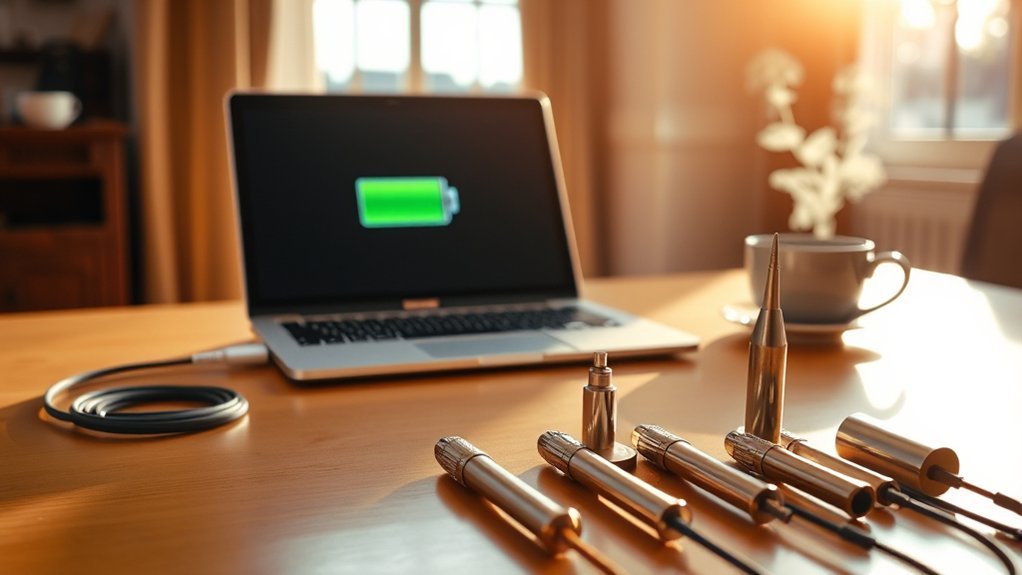Calibrating your laptop battery is a subtle art that can greatly improve its performance. By following five precise steps, you can guarantee your battery accurately reflects its capacity. Start by evaluating the battery’s health, then move on to charging and discharging it carefully. This process not only enhances accuracy but also extends the battery’s life. Curious about the specific actions you’ll need to take? Let’s break down each step.
Check Battery Health
Before you begin calibrating your laptop battery, it’s essential to check its health to guarantee peak performance. Start by accessing your laptop’s battery report, which provides valuable insights into its condition. On Windows, you can generate this report by running the command “powercfg /batteryreport” in the Command Prompt. For macOS, hold the Option key and click the Apple menu, then select “System Information” and look under the Power section. Examine key metrics like cycle count and design capacity versus current capacity. If your battery is nearing its cycle limit or shows significant degradation, it may need replacement. Understanding your battery’s health empowers you to optimize performance and extend its lifespan, ensuring you stay untethered and efficient.
Fully Charge Your Battery
To start the calibration process, fully charge your laptop battery until it reaches 100%. Connect your laptop to the charger and let it charge uninterrupted. Verify you’re using the original charger for peak performance. While charging, avoid using power-intensive applications that might slow down the charging process. Keep an eye on the battery icon; it should indicate when it’s fully charged. Once it hits 100%, allow the battery to stay connected to the charger for an additional hour. This helps the battery management system recognize the full capacity of your battery. After this, you can proceed to the next step in calibration. Properly charging your battery is essential for an accurate calibration and enhances your laptop’s overall performance.
Discharge the Battery Completely
Once your laptop battery is fully charged, the next step is to discharge it completely. This process allows the battery’s internal circuitry to recalibrate correctly. Follow these steps to guarantee effective discharge:
- Unplug your charger: Disconnect any power sources and let the laptop run on battery alone.
- Close unnecessary applications: Reduce power consumption by shutting down programs you don’t need.
- Adjust settings: Lower the screen brightness and turn off Wi-Fi to conserve battery life.
- Use the laptop until it powers down: Continue working until the battery drains completely, forcing the laptop to shut off.
Recharge to 100
Recharging your laptop battery to 100% is crucial for effective calibration and guarantees that the battery’s capacity is accurately recognized. Begin by plugging in your laptop and allowing it to charge uninterrupted until it reaches full capacity. Keep an eye on the charge indicator to confirm when it hits 100%. Avoid using your laptop during this charging phase to make certain the battery receives a complete charge without any distractions or energy draw. This step not only resets the battery’s internal gauge but also helps in enhancing the overall longevity and performance of the battery. By fully recharging, you’re setting the stage for precise calibration, allowing your laptop to function at its best and efficiently.
Repeat the Process if Necessary
If your laptop battery still isn’t showing accurate readings after the initial calibration, don’t hesitate to repeat the process. Follow these steps to improve accuracy:
- Fully Charge: Plug your laptop in and let it charge to 100% without interruption.
- Discharge Completely: Use your laptop until it shuts down from low battery, ensuring it reaches 0%.
- Rest Period: Leave your laptop off for at least 5 hours to reset the battery’s internal gauge.
- Recharge Again: Charge it back to 100% without using it during this time.
Frequently Asked Questions
How Often Should I Calibrate My Laptop Battery?
You should calibrate your laptop battery every few months or whenever you notice significant performance drops. This guarantees accurate readings and helps maintain battery health, optimizing your device’s overall efficiency for a better user experience.
Will Calibration Improve My Battery Life?
Calibration won’t directly improve your battery life, but it helps guarantee accurate readings, allowing you to manage power better. Think of it as tuning a fine instrument, enhancing your laptop’s performance and longevity.
Can I Use My Laptop While Calibrating the Battery?
You can’t use your laptop while calibrating the battery effectively. It requires a full discharge and recharge cycle, which means you’ll need to let it sit undisturbed for accurate results. Prioritize this process for peak performance.
What Tools Are Needed for Battery Calibration?
You’ll need a fully charged laptop, a power adapter, and battery calibration software. Some laptops include built-in calibration tools, while others may require third-party applications. Verify your device’s drivers are updated for accurate results.
Does Battery Calibration Affect My Warranty?
Yes, battery calibration typically doesn’t affect your warranty. However, if you’re using unauthorized tools or methods, it could void your warranty. Always check your manufacturer’s guidelines to confirm you’re covered while maintaining your laptop’s performance.
Conclusion
To sum up, calibrating your laptop battery is essential for peak performance. By checking the battery health, fully charging, completely discharging, and recharging, you can guarantee accurate charge readings. If you find yourself facing battery issues, don’t hesitate to repeat the process. Remember, a well-maintained battery is worth its weight in gold, so take these steps to keep your laptop running smoothly. With a little effort, you’ll extend your battery life and improve your overall experience.

